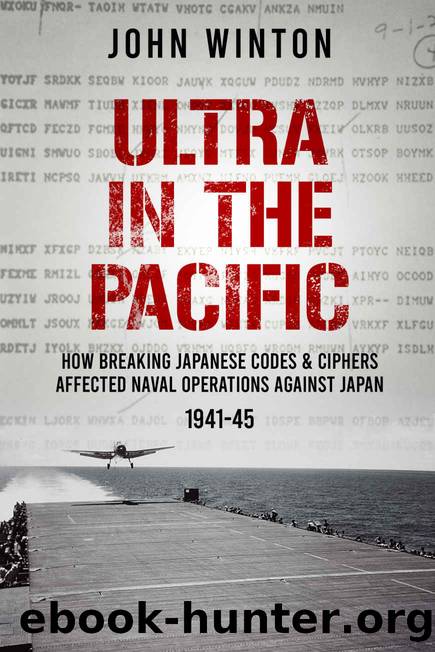Ultra in the Pacific: How Breaking Japanese Codes and Ciphers Affected Naval Operations Against Japan, 1941-45 (The Secret War) by Winton John

Author:Winton, John [Winton, John]
Language: eng
Format: epub
Publisher: Sapere Books
Published: 2022-05-15T00:00:00+00:00
IX: THE SUBMARINE WAR â BREAKING THE MARU CODE
âPRESS home all attacks,â wrote Rear Admiral James Fife USN, Commander Submarines South-West Pacific, in his standing orders. âPursue relentlessly, remembering that the mission is to destroy every possible enemy ship. Do not let cripples escape or leave them to sink â make sure that they do sink.â
The American submariners in the Far East, very ably assisted by the British and the Dutch, put Admiral Fifeâs orders faithfully into effect and achieved devastating results. By VJ Day, 1945, Allied submarines in the Far East were actually running out of targets. By that time, although submarines still constituted only 2 per cent of the American war effort on the Pacific, American submarines had sunk two-thirds of the total Japanese merchant ship tonnage sunk during the war, and had also sunk one out of every three of the Japanese warships sunk.
The United States and the Imperial Japanese Navies were roughly equal in submarine strength in the Pacific at the outset of the war. Neither navy had had any operational experience of submarines in the First World War. Both had prepared for submarine warfare on a long-range scale, and primarily for use against enemy warships. The crucial difference in the Second World War lay in the US Navyâs technological advances, its readiness to profit by tactical experience, and its proper strategic deployment of its submarines. In all three areas the Americans were superior.
At the time of Pearl Harbor the US Navy had some fifty-five submarines in the Pacific, about half of them at Pearl and the rest with the Asiatic Fleet in the Philippines. Some of the boats were of the older and smaller S-class, of 800 to 1,000 tons, but the standard Gato Class fleet-type submarine, which carried the heat and burden of the day in the Pacific submarine war, was an excellent long-range weapon, of some 1,500 tons, with a crew of seven officers and seventy men, a cruising range of 10,000 miles, stores for sixty-day patrols, a surface speed under diesel-electric propulsion of just over 20 knots, and a maximum submerged speed of just under 9 knots. The submerged endurance on batteries was 48 hours at 2½ knots. These submarines were armed with eight to ten 21-inch torpedoes, with eighteen reloads, a 3-inch and, later, 5-inch gun on deck and various outfits of .50 calibre anti-aircraft guns.
The Japanese had sixty submarines, forty-seven of the fleet-type I-Class and thirteen of the smaller RO-Class. The I-Class were of some 2,000 tons, with a surface speed of 24 knots and submerged speed of 8 knots, and a cruising range of 10,000 to 17,500 miles. They were armed with twenty-four 21-inch torpedoes in six to eight tubes, with eighteen reloads. They also had one or two deck guns of 4.7- to 5.5-inch, with several AA guns.
The one advantage the Japanese submarines had was the quality of their formidable 40-knot, oxygen-powered, longer ranged torpedoes, with twice the explosive charge of the American torpedoes.
American torpedoes were frequently defective
Download
This site does not store any files on its server. We only index and link to content provided by other sites. Please contact the content providers to delete copyright contents if any and email us, we'll remove relevant links or contents immediately.
The Vikings: Conquering England, France, and Ireland by Wernick Robert(79219)
Ali Pasha, Lion of Ioannina by Eugenia Russell & Eugenia Russell(39937)
The Vikings: Discoverers of a New World by Wernick Robert(36830)
The Conquerors (The Winning of America Series Book 3) by Eckert Allan W(36715)
Cecilia; Or, Memoirs of an Heiress — Volume 1 by Fanny Burney(32090)
Cecilia; Or, Memoirs of an Heiress — Volume 3 by Fanny Burney(31480)
Cecilia; Or, Memoirs of an Heiress — Volume 2 by Fanny Burney(31434)
Empire of the Sikhs by Patwant Singh(22779)
Hans Sturm: A Soldier's Odyssey on the Eastern Front by Gordon Williamson(18340)
The Secret History by Donna Tartt(18261)
Cat's cradle by Kurt Vonnegut(14803)
Sapiens: A Brief History of Humankind by Yuval Noah Harari(14005)
Pimp by Iceberg Slim(13826)
Talking to Strangers by Malcolm Gladwell(12912)
Norse Mythology by Gaiman Neil(12878)
Leonardo da Vinci by Walter Isaacson(12831)
Underground: A Human History of the Worlds Beneath Our Feet by Will Hunt(11857)
4 3 2 1: A Novel by Paul Auster(11840)
The Radium Girls by Kate Moore(11648)
